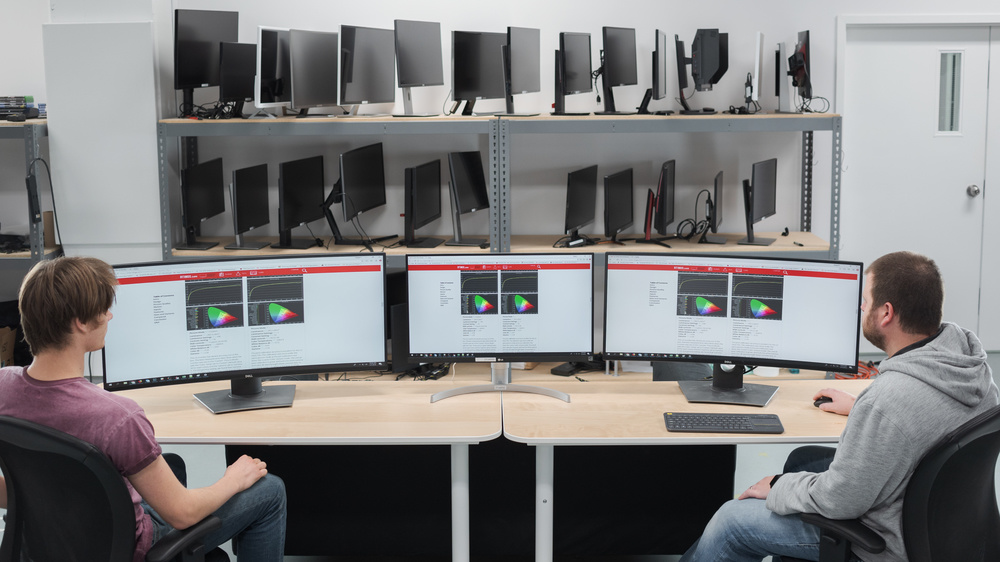There are a few factors to consider when purchasing a computer monitor for your home office. The size of the monitor is important, as you’ll want something that will fit comfortably on your desk. You’ll also want to consider the resolution and refresh rate, as these will affect how clear and smooth your image is.
Finally, think about whether you want a touchscreen or not – this can be a useful feature if you’re working with graphics or other visual media.
If you work from home, or even if you just want a better computer setup for general use, you need a good monitor. But what makes a monitor great for a home office? Here are our top picks for the best monitors for your home office, whether you’re looking for an affordable option or something with all the bells and whistles.
First up is the ASUS VG245H, which is our budget pick. This 24-inch monitor has Full HD resolution, 75Hz refresh rate, and 1ms response time. It also has AMD FreeSync technology to reduce screen tearing.
The VG245H isn’t loaded with extras, but it’s a great value for a quality monitor.
If you’re looking for something with a little more to offer, check out the Dell U2718Q. This 27-inch monitor has 4K UHD resolution, 99% sRGB coverage, HDR10 compatibility, and USB-C connectivity.
It’s also adjustable so you can find the perfect viewing angle. The only downside is that it’s not as affordable as our budget pick.
Finally, if you want the best of the best (and are willing to pay for it), take a look at the LG UltraFine 5K Display.
This massive 27-inch monitor has 5120×2880 resolution and P3 wide color gamut support. It also includes three USB-C ports for charging devices or connecting peripherals..

Credit: www.popsci.com
Which Monitor is Best for Home Office Use?
There is no one-size-fits-all answer to this question, as the best monitor for home office use will vary depending on individual needs and preferences. However, there are a few factors to consider when choosing a monitor for a home office setup, which include resolution, size, portability, and ergonomics.
Resolution is an important consideration for any monitor, but especially so for those who will be using it for work purposes.
A higher resolution means that text and images will appear sharper and more detailed, making it easier to read and work with documents and spreadsheets. Size is also an important factor to consider – a larger monitor may be more expensive but can make working on long documents or complex projects much easier. Portability can be important if you need to move your monitor around frequently or take it with you when traveling for work; however, keep in mind that portable monitors often have lower resolutions than their non-portable counterparts.
Finally, ergonomics should be taken into account when choosing a home office monitor; look for features like adjustable stand heights and viewing angles to ensure that you can position the screen in a way that is comfortable for extended use.
Is a 32-Inch Monitor Too Big for Office Work?
When it comes to monitors, size definitely matters. But is a 32-inch monitor too big for office work? It really depends on the type of work you do and your personal preferences.
If you have a lot of data or Spreadsheets to analyze, then a larger monitor can be extremely helpful in reducing eye strain and fatigue. However, if you primarily use your computer for writing documents or browsing the web, then a smaller monitor might be more suitable. Ultimately, it’s up to you to decide what size works best for your needs.
Which Monitor is Best for Long Working Hours?
When it comes to monitors, there is no one-size-fits-all answer to the question of which one is best for long working hours. However, there are certain features that can make a monitor more suitable for extended use. Here are some things to look for when choosing a monitor for long working hours:
1. Screen Size and Resolution: A larger screen size and higher resolution will help reduce eye strain and fatigue over long periods of use. If you can afford it, opting for a 27″ or 30″ monitor with at least 1920×1080 resolution is ideal.
2. Adjustability: Being able to adjust the height, tilt, and swivel of your monitor can help you find the most comfortable viewing position, which is important for preventing neck and back pain during extended use.
3. Anti-Glare Coating: An anti-glare coating on your monitor’s screen will help reduce eye strain by reducing the amount of harmful blue light emitted by the display.
Is a 4K Monitor Worth It for Home Office?
A 4K monitor is a worthwhile investment for anyone who wants the best possible image quality for their home office. 4K monitors provide four times the number of pixels as a standard 1080p HD monitor, resulting in an incredibly sharp image. Not only will text and images look better on a 4K monitor, but you’ll also be able to see more detail when working with video or photo editing software.
If you’re looking for a top-of-the-line home office setup, then a 4K monitor should definitely be part of your plans. However, keep in mind that you’ll need a powerful computer to drive such a high-resolution display. Make sure your graphics card is up to the task before making the switch to 4K.
The BEST Work From Home PRODUCTIVITY monitor – 2021 GUIDE
Best Budget Monitor for Home Office
When it comes to choosing a monitor for your home office, there are a few things you need to take into account. First, what is your budget? Second, what is the size of your space?
And third, what type of work will you be doing on your computer? With those factors in mind, we’ve rounded up the best budget monitors for your home office, whether you’re looking for a big screen or something more compact.
Asus VG245H 24-Inch Full HD FreeSync Gaming Monitor
If you have a small budget and are looking for a large screen, the Asus VG245H is the best option. It’s a 24-inch LED-backlit LCD monitor with full HD resolution (1920 x 1080). It has a fast 1ms response time and supports AMD FreeSync technology to reduce screen tearing.
The ASUS Eye Care Technology minimizes eye fatigue during long hours of use. You can also tilt and swivel the monitor to find the most comfortable viewing angle.
Acer SB220Q bi 21.5 Inches Full HD (1920 x 1080) IPS Ultra-Thin Zero Frame Monitor
The Acer SB220Q bi is another great option if you’re looking for an affordable large screen monitor. It’s 21.5 inches and has full HD resolution (1920 x 1080). The IPS panel provides excellent color accuracy and wide viewing angles.
The ultra-thin design makes it perfect for smaller spaces or if you want to save desk space. Plus, the built-in speakers mean you don’t have to worry about buying separate speakers.
Conclusion
If you work from home, then you know how important it is to have a good computer monitor. After all, you spend most of your day staring at it! But with so many different monitors on the market, it can be hard to know which one is right for you.
Here are some things to keep in mind when choosing a computer monitor for your home office:
1. Size Matters: Make sure to get a monitor that’s big enough for your needs. If you’re constantly scrolling back and forth, you’ll want at least a 19-inch screen.
2. Resolution Is Key: A high resolution will make text and images look sharper. If you’re doing any kind of graphic design work, look for a monitor with at least 1920 x 1080 resolution.
3. Refresh Rate Counts: A higher refresh rate means less eye strain and fewer headaches.
60 Hz is the minimum you should accept, but if you can find a monitor with 75 Hz or even 100 Hz, that’s even better.
